- Botanical Description
- Chemical Composition
- Therapeutic Properties
- Procurement of raw materials
- Methods of application
- Precautions
Genus Gentian of the Gentian family includes about 400 species of perennial, less often annual grasses and semi-shrubs. In natural conditions, its representatives can be found mainly in temperate zones in the Northern Hemisphere: in China, Siberia, Kazakhstan, Western Europe, Japan, and the Caucasus. Many of the gentian species have a medicinal value. They have valuable healing properties that were known and actively used in ancient Egypt and Rome for diseases of the digestive tract, tuberculosis, plague, cramps, for the treatment of bruises and bites of poisonous animals. These include the gentian yellow, large leaf, rough, pulmonary, Dahurian, cruciform, spring and other species. Some plants of the genus Gorechavka, mainly with large flowers, are of decorative value and are used to decorate gardens, flower beds, lawns, alpine hills.

Botanical description
Gentian prefers alpine and subalpine meadows, occurs in steppes, fringes, slopes, thickets of shrubs, valleys of lakes and rivers. It mainly lives at an altitude of 1.2 - 2 km above sea level. The plant is quite hardy, it adapts easily to any conditions of the terrain in nature. Prefers stony, drained soils, not very well tolerates direct sunlight and dry ground. Reproduction is carried out by seeds.
Important: Some plant species are rare in nature and even belong to endangered. Among them, the gentian yellow, the natural habitat of which is constantly shrinking, which is why it was listed in the Red Book and protected everywhere.
The height of plants of the genus Gentian varies from 20 cm to 1.5 m. The stems are short, straight or ascending. The root system is well developed, consisting of a thick short root and thin cordlike roots. The layout is opposite. Leaves are whole, fastened directly to the stem, without petioles. The shape of the leaf blade is linearly lanceolate, ovoid or linear.
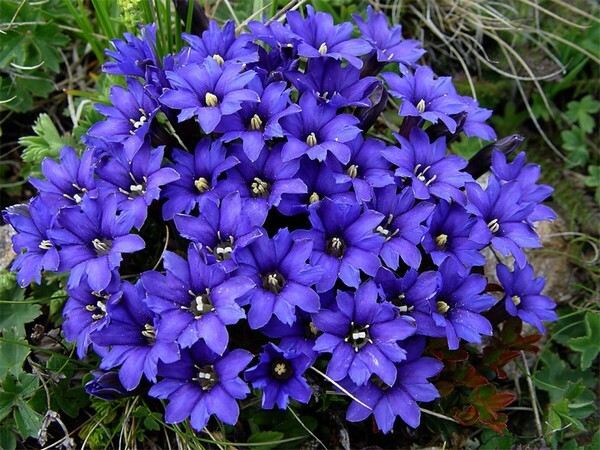
The flowering period is from spring to autumn, depending on the particular species. Gentian flowers are large in length from 2 to 5 cm, practically odorless, mostly blue, violet or blue in various shades, some species are yellow or white. Can be single, paired or form inflorescences - elongated or capitate semi-zonotics. In different plant species, the flowers are located at the top of the stems, in leaf axils, sessile or on long pedicels. Corolla tubular, funnel-shaped or campanulate, consists of 5, less often of 4 petals. Calyx tubular or campanulate, schistolevistnaya of 4 or 5 linear lobes. At night or in cloudy weather, the flowers are closed, and in the morning they open with the rising of the sun.
Fruits are bivalve skinny capsules, growing from a single-cavity ovary, inside which a lot of small seeds ripen. The period of fruiting lasts until late autumn.
Chemical composition of
The main active substances of the gentian are bitter glycosides( amarogenetin, amarosverin, gentiopicrin, amaropanin, sciociamarin).Their high content in plants causes a bitter taste of all their parts, due to which this genus got its name. In addition to glycosides in the roots were found:
- alkaloids( gentsianin, gentsyaljutin, gentsianidin, gentzioflavin, gentiopunctin,);
- pectin substances;
- polysaccharides( inulin, gentianose, gentiobiose, sucrose);
- tanning agents;
- iridoids( scabroside, scertiamarin, sporoside, gentionikrozid, trifloroside);
- resins;
- mucus;
- flavonoids;
- fatty and essential oils;
- Phenylcarboxylic acids.
In the aerial parts of the plant there are also biologically active substances( coumarins, vitamins, flavonoids), but they are not used for medicinal purposes.
Interestingly: From the roots of gentian glycosides, amarogen and gentiopicrin are distinguished as the most powerful components for the production of bitterness. The taste of amarogenetine can be felt even if it is diluted with water in the proportion of 1 to 50,000.
Therapeutic properties of
The glycosides contained in the gentian gel have a beneficial effect on the functioning of the digestive system:
- stimulates the secretion of gastric juice and the secretory activity of the digestive glands;
- whets appetite;
- improves the formation and separation of bile;
- have an antispasmodic effect;
- strengthen motility of the digestive tract.
Means based on the plant have anti-inflammatory and antiseptic effect, enhance heart contractions. Due to the presence in the alkaloid gencianin, they contribute to suppressing cough, reducing seizures, lowering the temperature, have a sedative effect. Phenylcarboxylic acids increase the evacuation function of the stomach.
Gentian is effective for the following disorders in the body:
- lack of appetite;
- deviations from the norm of the composition of gastric juice;
- anemia;
- diseases of the liver, spleen, gallbladder;
- diathesis;
- arthritis, gout;
- scurvy;
- inflammation in the stomach;
- flatulence, constipation;
- tuberculosis and lung diseases;
- malaria;
- general weakness due to severe illnesses.
Gentian yellow
The gentian yellow is used most widely in folk medicine to treat digestive disorders, heartburn, constipation, intestinal colic and to increase appetite. It is also effective in the event of loss of strength, nervous exhaustion, and circulatory disorders. With external application, the products from it promote the healing of suppurating wounds and ulcers on the skin, help with excessive sweating of the feet, from insect bites, snakes and animals. Gentian yellow is recognized as a medicinal plant in traditional medicine. Its root is a part of such herbal preparations as Bittner's balm and Dr. Tiss's Swedish bitterness, the homeopathic drug Aflubin, widely used in children and adults for therapy and prevention of flu and cold.
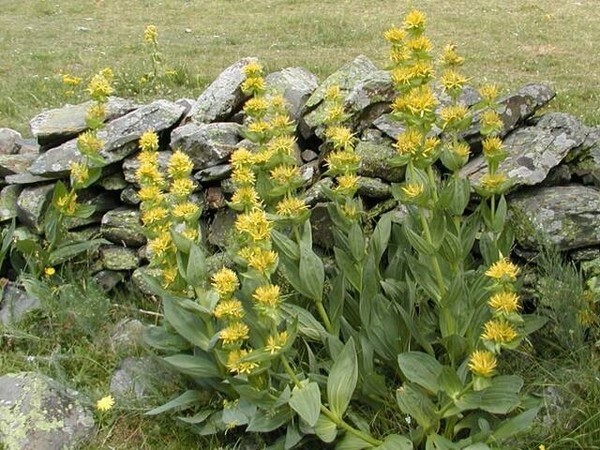
Interesting: Gentian yellow is used in the manufacture of some alcoholic beverages to give them a kind of bitter taste.
Gentian pulmonary
Gastrointestinal pulmonary is also used to treat diseases of the digestive system. However, in addition to being used for medicinal purposes, this flower is also of decorative value. Means from its root have an antihelminthic effect, normalize the tone of the uterus, reduce the amount of discharge during menstruation. Ground parts of the plant in the form of water infusions are used in violation of the functions of the nervous system, apathy, lethargy.

Gentian Daurian
An effective antipyretic, antirheumatic, hemostatic and anti-inflammatory agent is the Daurian gentian. It helps to normalize metabolism, improve the digestive system, increase appetite, has a diuretic, analgesic, antitumor, antispasmodic effect, stimulates the potency in men. The plant can be used as a common restorative for influenza epidemics, to eliminate and alleviate muscle and joint pain. Similar healing properties have a gentian spring, which also has a sedative effect.
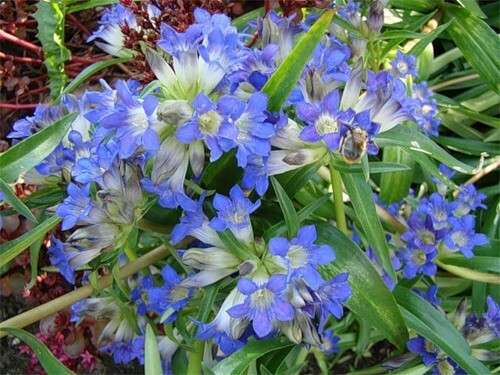
Gentian cruciform
Infusion of roots of gentian cruciform helps with impotence, painful and poor menstruation, hemorrhoids, digestive tract diseases, helminthic invasions and as a restorative. Herb plants can be used in diseases of the kidneys, inflammatory processes in the urinary system, the presence of sand in the kidney or bladder, with nephrolithiasis in the event that according to the US no large stones are found.
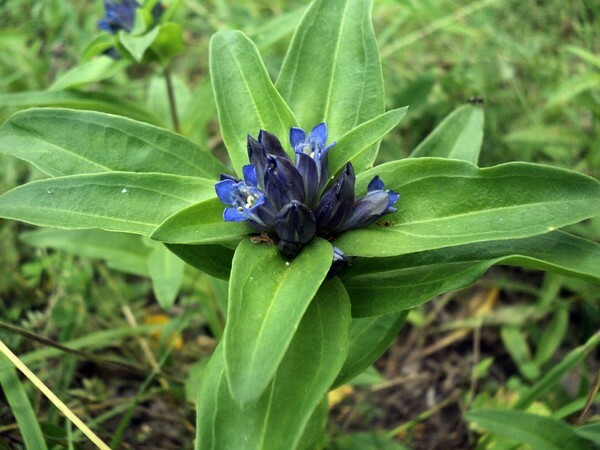
Gentian, large leaf
The healing properties of the large-leafed gentian are used for seals in the mammary glands, tuberculosis, uterine bleeding of various etiologies, including before and after childbirth, uterine prolapse, hepatitis, neurasthenia, insomnia, and neoplastic diseases. It is effective for colds, flu and inflammations of the respiratory system( tracheitis, laryngitis, bronchitis).Outer her infusions and decoctions are used to treat wounds, with bruises, burns and frostbite.
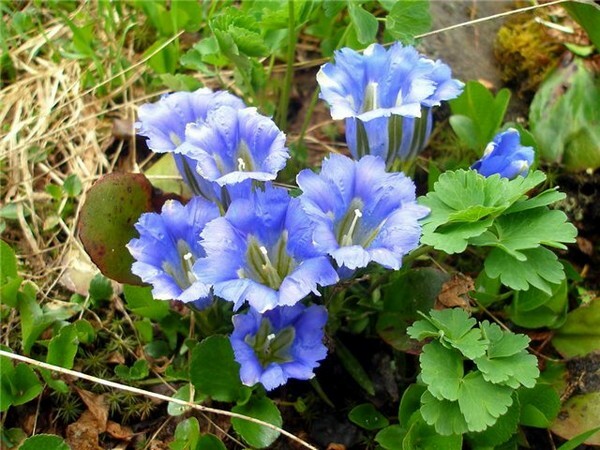
Raw material preparation
Billet of gentian roots is produced in spring or autumn. For medicinal purposes, plants older than 4 years are used. Roots are gently excavated from the ground, cut off from the stems, cleaned of soil and foreign impurities, quickly washed under a stream of cold water.
Then they are cut into pieces up to 15 cm long and dried in the shade in the air, in the attic or in dryers at a temperature of no more than 40 ° C.Store finished raw materials in a cool dry place for no longer than 5 years. The dried roots of the gentian yellow outside have a reddish brown color, and on the fracture are yellow and smooth, have a weak honey smell and a specific bitter taste.
Important: Dry roots should be produced as quickly as possible, otherwise they lose some of their healing properties.
Billet of gentian grass is carried out during flowering of plants, cutting off the tops of stems with leaves. The cut stems are bundled in bundles of 8 - 10 pieces and dried, hung in the street in the shade or in a ventilated room.
Ways of using
In folk medicine, gentian is applied externally and inwardly in the form of infusions, decoctions, alcohol tinctures and dry powder. For their preparation raw materials are harvested independently or bought in a pharmacy.
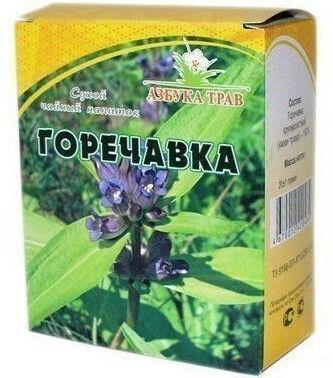
Decoction in case of loss of strength and nervous exhaustion
Add a glass of boiling water to the mixture of ground grass and gentian roots of yellow( 2 tsp) and boil for 10 minutes. Then allow to cool to room temperature, filter out and consume 100 ml three times a day for 30 minutes before meals.Means for increasing appetite
The dried root of the gentian yellow is ground. The obtained powder in an amount of 1 tbsp.l.put in a pan, pour ¼ of water and cook over low heat for 10 minutes. Take the resulting broth for 15 minutes before eating 20 ml each. In the absence of appetite and poor digestion, the powder from the gentian root can be taken at the tip of the knife 30 minutes before eating and in dry form.
Broth for rheumatism, gout, arthritis
Dry root gentian( 1 tsp with a slide) pour 300 ml of boiling water, bring to a boil and cook on low heat for a quarter of an hour. Insist for 2 hours, then filtered. The resulting solution is taken 20 minutes before a meal of 100 ml for one day. Every day a new broth is prepared, as it is not subject to long-term storage.
Decoction of the roots from the sweating of the feet
The root of the gentian( 5 tbsp.) And the bark of oak( 3 tbsp.) Is boiled in 1 liter of water for 10 minutes. Then give a little cool, filter and use externally in the form of foot baths daily before bedtime. If necessary, you can add a little water to the bath.
Remedy for suppurating wounds and ulcers
From the root of gentian and chamomile flowers powder is prepared in a ratio of 1 to 1 and they pour problem spots on the skin.
Precautions
Along with the healing properties of gentian has contraindications. Most species can not be used for treatment in the following cases:
- bitter intolerance or plant allergy;
- pregnancy and breastfeeding;
- hyperacid gastritis;
- high blood pressure
- peptic ulcer of the stomach or intestines.
Gentian cruciate, in addition to the points listed above, is contraindicated for treatment of people with severe chronic kidney disease.
Before using gentian, consult a doctor. Overdosing of funds from the plant leads to suppression of the emotional background, a depressive state, the appearance of headaches, dizziness, reddening of the face.
About the gentian yellow:
